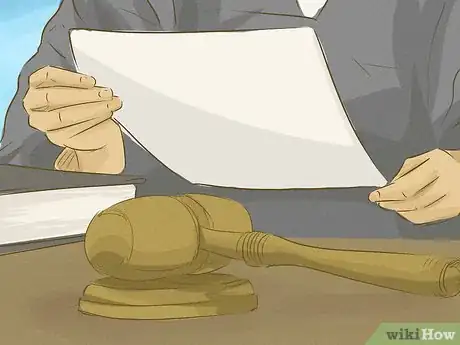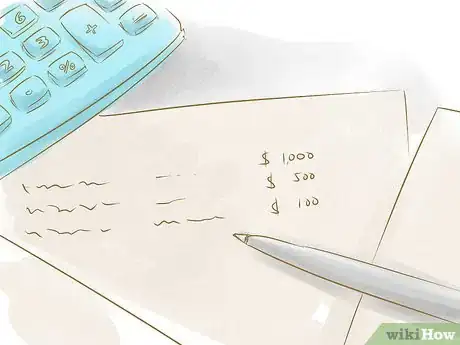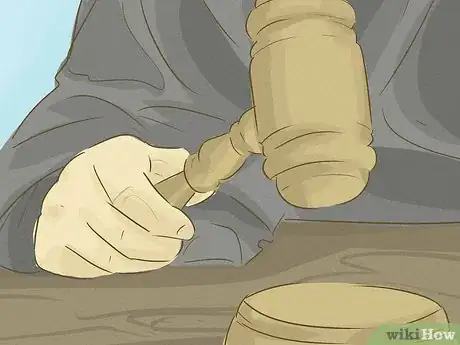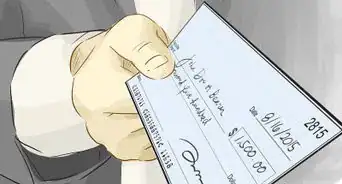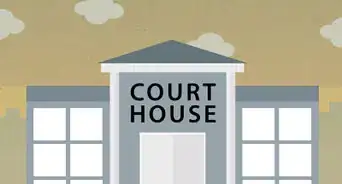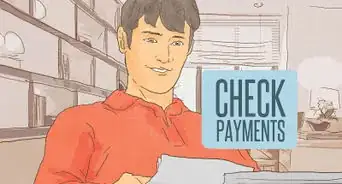This article was written by Jennifer Mueller, JD. Jennifer Mueller is an in-house legal expert at wikiHow. Jennifer reviews, fact-checks, and evaluates wikiHow's legal content to ensure thoroughness and accuracy. She received her JD from Indiana University Maurer School of Law in 2006.
There are 8 references cited in this article, which can be found at the bottom of the page.
This article has been viewed 31,684 times.
When a court orders child support payments, you can be declared in contempt of court for failure to make those payments. If you're found in contempt, the court may impose a host of sanctions under federal and state law, including the suspension of your driver's license or any professional licenses and the interception of your tax refund. Depending on the amount you owe, you also may face criminal penalties including fines or even jail time.[1] When you have back child support, there are ways to pay it without incurring these harsh penalties. However, you should make every effort to deal with the situation as soon as possible to avoid the most severe penalties.
Steps
Reaching a Settlement
-
1Get a full account record. Ask the child support enforcement agency for their record of your payments and make sure their record matches your own.
- If the agency's account contains any errors, you should get those corrected before you arrange a settlement.[2]
- The agency may be charging interest on any back child support. If you plan to negotiate a settlement, it's important to know how much you actually owe in arrears and how much of that amount is interest. Often you can get some of the interest waived if you're willing and able to pay a lump sum.[3]
-
2Contact the other parent. If you are on speaking terms with your ex, she may be willing to help you by agreeing to take less money.[4]
- For example, if you were unable to pay child support due to a hardship such as a sudden job loss or medical problem, your ex may be more understanding about cutting you a break – especially if you've owed the money for awhile.
- Keep in mind that if your ex has already received the child support she was due under the order and you owe the money directly to the agency, this option may be irrelevant since she isn't actually owed any money.
- For example, if the children are on public assistance, the state collects the child support and sends a portion of it to the parent, while the rest is used to pay back the public assistance.[5]
Advertisement -
3Negotiate a settlement. It can help settlement negotiations if you have a good reason for your inability to pay in the past, and express an earnest interest and ability to pay now.
- Typically you have better odds of reaching a settlement if you can pay a significant portion of your arrears in a lump sum. You might consider taking out a private loan to cover a lump sum amount, then paying back the loan.[6]
- Considering the interest rates some states charge for back child support – California, for example, charges 10 percent per year – you may be able to get a private loan that covers your arrears at a lower interest rate, thus saving you money.
-
4Write up a settlement agreement. If you're able to reach an agreement to pay your back child support, make sure you get that agreement in writing – particularly if you'll be paying less than the total amount you owe.
- A written agreement prevents the other parent from going to court later and claiming no such deal was made, or that she was unaware of the deal.
-
5Get court approval of your settlement. Any settlement agreement that results in you paying less than you owe under the court's original order should be approved by the court.
- Technically, such a settlement agreement constitutes an amendment of the original court order.
- If your settlement agreement is approved by the court, it becomes enforceable to the same extent as the original order.
- In many states, you must get judicial approval of any independent agreement you make with the other parent in which she waives the right to receive back child support or to a reduction of the amount you owe.
- Typically private agreements regarding the amount of child support to be paid are not enforceable until they are approved by the court and incorporated into a court order.[7]
Arranging a Payment Plan
-
1Analyze your budget and expenses. Before you agree to make payments, you should review your own finances so you know the amount you can afford each month.
- Although back child support is one debt you can't discharge in bankruptcy, if you have significant consumer debt including credit card debt, you might consider filing for bankruptcy to free up additional funds each month that you can use to pay your child support arrears.[8]
- Additionally, some states such as California allow for a suspension of interest on arrears if you file Chapter 13 bankruptcy. To qualify, you must have a job and be able to pay all your back child support within five years.
-
2Research your state's debt compromise law. Many states have programs to settle a portion or all of the debt owed to the state.[9]
- Statutory programs exist in 29 states, with another 17 states that are willing to compromise debt on a case-by-case basis. In some of those states such as Maine and South Carolina, debt forgiveness is rare. Others such as Pennsylvania require court approval of all agreements to compromise child support debt.[10]
- Five states do not allow any compromise of back child support, including interest owed: Arkansas, Idaho, Mississippi, Missouri, and Virginia.[11]
- Some plans require continuous payments for a period of time before any amount of back child support owed will be forgiven. For example, Alabama's child support debt compromise law allows for forgiveness of interest on arrears if you pay current child support for at least 12 consecutive months.[12]
- Some state laws require the agreement of the custodial parent before any back child support, including interest, will be forgiven.[13]
-
3Contact the child support enforcement agency. If you live in a state with a debt compromise program, you may be eligible only if you owe back child support to the state agency rather than to the other parent directly.
- The U.S. Department of Health and Human Services has a map of all the state child support agencies with debt compromise policies at http://www.acf.hhs.gov/programs/css/state-child-support-agencies-with-debt-compromise-policies-map.
- You may have to work with the agency to create a plan that fits in your budget, but continue to indicate a desire and willingness to pay your debt.[14]
-
4Get any agreement in writing. The agency should send you a full accounting of the amount you owe, the amount of the monthly payments, how those payments will be made, and how long you must make payments before your back child support will be considered paid in full.
- Make sure you understand the terms of the agreement before you agree to it, particularly if payments are being automatically deducted from a bank account or withheld from your paycheck.
Filing a Motion in Court
-
1Consider hiring an attorney. Since unpaid back child support can result in stringent civil and criminal penalties, an experienced family law attorney may be best able to protect your interests.
- Federal law empowers states to take enforcement measures such as freezing bank accounts, suspending professional licenses or driver's licenses, and placing liens against your real or personal property.[15] If any of these actions have been taken, it is all the more important that you hire an attorney to help you roll back these measures.
- Although you may be able to work something out on your own, an experienced attorney knows all the options available to you in your state and can determine based on your situation which motion or petition will best achieve the result you want.
-
2Get a copy of the original child support order. You should review the original order carefully to ensure there are no errors. Although it may be too late to have the order amended, an error in calculation can be used to argue for a reduction in the arrears you owe.
- Other errors may be used to set aside the judgement. For example, you may have been improperly served with the order because it was mailed to the wrong address. If such an error exists in your case, you may be able to get the amount of back child support you owe reduced as well as eliminating any interest charged as a result of your delinquency.
Advertisement -
3Get a full account history of your payments. Check the child support enforcement agency's record to make sure it matches yours and that there were no mistakes in processing your payments.
- If the agency failed to credit you for payments you made, you may be able to petition the court to have your back child support redetermined.
- While the court typically can't make retroactive changes, you can get the amount corrected if errors were made in crediting payments.[16]
-
4Draft the appropriate petition or motion. Depending on your state and situation, there are a number of petitions and motions available that you can file with the court to make arrangements to pay back child support.
- For example, most states allow you to file a petition for equitable forgiveness if you didn't pay child support because the child actually was living with you during a portion of the time you were supposed to be paying child support to the other parent.[17]
- You also may be able to file a motion to modify your current child support payments if your income has decreased substantially and you are unable to afford the current amount. Lowering your current payments can free up money to pay down your arrears.[18]
- Under federal law, courts cannot modify child support retroactively, but you may be able to at least get your current payments lowered.[19]
- Most states have forms available for the most common motions that you can fill out yourself if you don't have an attorney.[20]
-
5File your motion with the court that issued the original order. Under federal law, the court that issued the original order has continuing jurisdiction over your child support case.[21]
- You typically have to pay a filing fee to file your motion, often around $100. If you are unable to pay the fee, you can ask the clerk for an application to have the fee waived. The judge will approve your application if you meet the court's financial requirements.[22]
- After your motion is filed, you will be responsible for serving the other parent with a copy of the motion. Usually you can either have a sheriff's deputy give the motion to her personally, or you can mail it using certified mail. The clerk of court will be able to give you more information about service when you file your motion.[23]
- If you can reach an agreement with the other parent so she supports your motion, the process will go much more smoothly. The judge is far more likely to approve your motion if both parents are in agreement.[24]
-
6Attend your hearing. Depending on the type of motion or petition you filed, the judge may order a hearing so he can review and decide the matter.
- Bring copies of all the documents you've filed along with any evidence that supports your motion or petition and bring them with you to court.
References
- ↑ http://family.findlaw.com/child-support/enforcement-and-collection-of-back-child-support.html
- ↑ http://www.moneycrashers.com/back-child-support/
- ↑ http://www.moneycrashers.com/back-child-support/
- ↑ http://www.moneycrashers.com/back-child-support/
- ↑ http://www.masslegalhelp.org/children-and-families/child-support
- ↑ http://www.moneycrashers.com/back-child-support/
- ↑ http://responsibledivorce.com/legal/child-support.htm
- ↑ http://www.moneycrashers.com/back-child-support/
- ↑ http://www.ncsl.org/research/human-services/state-child-support-debt-compromise-policies.aspx
- ↑ http://www.ncsl.org/research/human-services/state-child-support-debt-compromise-policies.aspx
- ↑ http://www.ncsl.org/research/human-services/state-child-support-debt-compromise-policies.aspx
- ↑ http://www.ncsl.org/research/human-services/state-child-support-debt-compromise-policies.aspx
- ↑ http://www.ncsl.org/research/human-services/state-child-support-debt-compromise-policies.aspx
- ↑ http://www.moneycrashers.com/back-child-support/
- ↑ http://family.findlaw.com/child-support/enforcement-and-collection-of-back-child-support.html
- ↑ http://responsibledivorce.com/legal/child-support.htm
- ↑ http://www.moneycrashers.com/back-child-support/
- ↑ http://www.legalmatch.com/law-library/article/modifying-child-support-payments.html
- ↑ http://responsibledivorce.com/legal/child-support.htm
- ↑ http://www.selfrepresent.mo.gov/page.jsp?id=38396
- ↑ http://family.findlaw.com/child-support/enforcement-and-collection-of-back-child-support.html
- ↑ https://www.courts.state.co.us/Forms/PDF/JDF%201403I%20Instructions%20to%20File%20Motion%20to%20Modify%20Child%20Support.pdf
- ↑ https://www.courts.state.co.us/Forms/PDF/JDF%201403I%20Instructions%20to%20File%20Motion%20to%20Modify%20Child%20Support.pdf
- ↑ http://www.selfrepresent.mo.gov/page.jsp?id=38396




